Arizona attracts affluent residents from other states like New York and California due to the Grand Canyon state’s warm weather and low taxes. In fact, a lot of buyers set their eyes on Paradise Valley, the richest city in the state as well as one of the richest in the United States. The town’s privacy, spacious lots, and proximity to Phoenix and Scottsdale for a taste of city life make living there appealing. It is even home to the largest house in Arizona!
Arizona’s largest home is the Walker McCune Mansion at a whopping 52,000 square feet! According to Forbes, it was once the 13th largest home in the United States!
According to the U.S. Census Bureau, the median household income in Arizona is $58,945, but the medium income in Paradise Valley is $211,393. The private oasis is where the state’s largest home resides. It also boasts Arizona’s most expensive house ever built at a whopping $75 million! Though the largest home is only the 100th largest house in the country, it isn’t that much smaller than the White House!
History Of Walker McCune Mansion: Largest Home in Arizona
The McCune Mansion sits in the wealthy enclave of Paradise Valley. The area’s median home price is $2.5 million, and even among all the luxury properties, the mansion stands out!
At 52,000 square feet, the Walker McCune Mansion is the largest completed single-family home in the state. It is located at 6112 N. Paradise View Drive, Paradise Valley, Arizona, 85253.
The home sits on 3.77 acres and the aerial photos of the home on Zillow show the 360-degree view of Camelback Mountain. Two pieces of land join the house’s meticulously kept grounds, bringing the total acreage to six. The photos also show ample parking, a large pool, and beautiful walkways and balconies around the home where owners can enjoy the beautiful Arizona sunsets.
Owners Of The Largest Home In Arizona
Walker McCune built the home in 1967. He spent around $5.2 million (equivalent to $49.2 million today) building the house. McCune is the grandson of the found of Standard Oil Company. His money came from his trust fund. Though he spent millions of dollars on the beautiful mansion, he actually never lived in the home. McCune went through a bitter divorce and died in 1971.
The home was purchased and renovated into what it is today in 1986 by Gordon Hall, a businessman and investor. He spent $1 million renovating the home and spent his time between the property and another home in Mesa. However, he didn’t get to enjoy the home for long as he was arrested by Federal agents in 1997 on fraud and racketeering charges and would end up in prison.

Paradise Valleys tucks away some of the world’s largest and most lavish homes.
©Tim Roberts Photography/Shutterstock.com
So, once again, the house changed hands. In 1992, the heir to the Hormel Foods company, Geordie Hormel, purchased the home. And once again, the owner didn’t relish in the artistry of the beautiful home. Instead, he lived in the three-bedroom guest house and his friends and family stayed in the main house. But he did live in the home until his death in 2006.
The home is currently for sale for $16 million with 14 bedrooms, 23 bathrooms, five kitchens, three levels of living space, and a 10-car garage. The guest house is 2,900 square feet which is the perfect amount of space if you want your family to live with you!
Facts About Walker McCune Mansion
- The mansion is only 15 minutes from Phoenix Sky Harbor Airport and 20 minutes from downtown Phoenix.
- Previous owners include: Gordon Hall, fitness mogul, and late heir to Hormel Foods, Geordie Hormel
- The stone wall encircling the home and raised walkways were purposely built to give the home a fortress look, complete with a guard house and gatehouse.
- Residents swim in an Olympic-sized swimming pool with his and hers locker rooms. This means the pool is over 164 feet in length whereas a standard swimming pool is usually 16 by 32 feet.
- The interior consists of marble and tile interiors along with an amethyst-clad fireplace.
- There is an ice rink that was originally built for McCune’s wife.
- The home boasts a 150-seat theater and a ballroom.
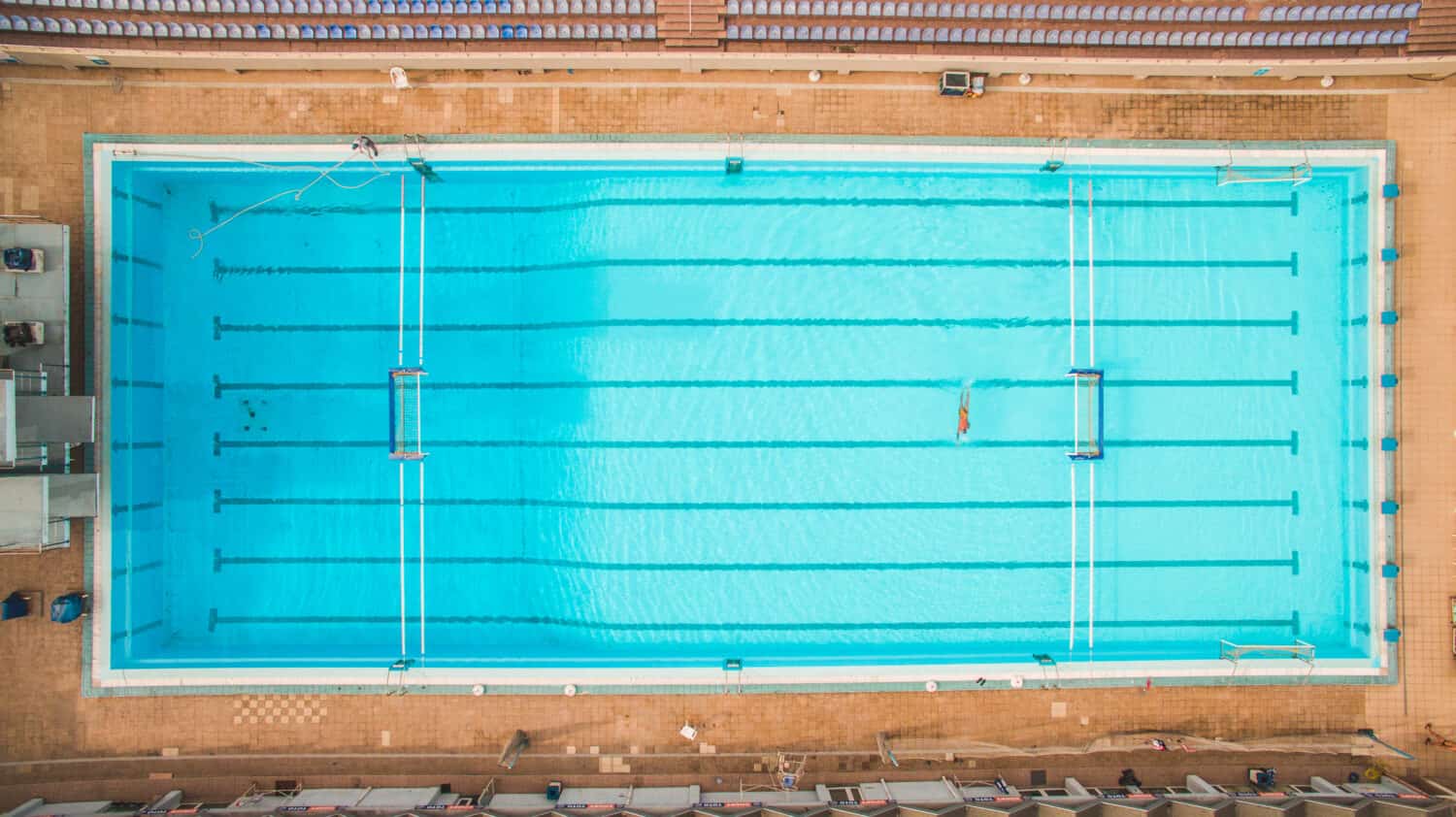
An Olympic size swimming pool sits on the grounds of the Walker McCune Mansion.
©Allexanderh/Shutterstock.com
Wildlife Near Walker McCune Mansion
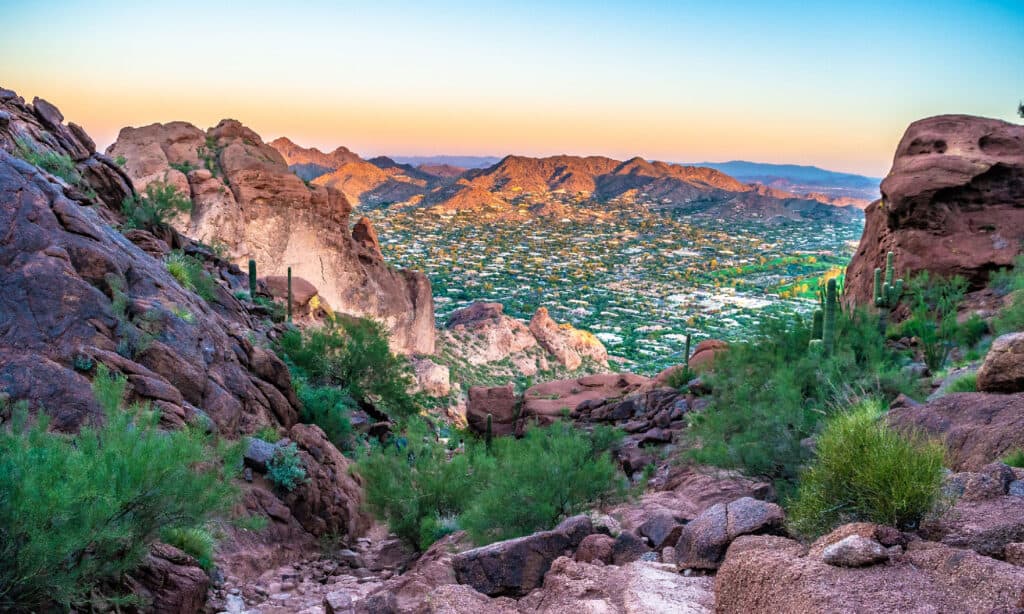
Camelback Mountain is known for its unique peaks, which are shaped like a camel in profile.
©iStock.com/Jeremy Janus
The home has gorgeous views of Camelback Mountain, named for its appearance of a kneeling camel. The desert climate of Phoenix and the surrounding areas like Paradise Valley and Camelback Mountain are home to species such as the desert tortoise, Chuckwalla lizard, cottontail rabbits, and rattlesnakes.
Rattlesnake
The rattlesnake isn’t just a native reptile in the mountains. In fact, a species of the snake, the ridge-nosed rattlesnake, is Arizona’s state reptile. This is a small rattlesnake that grows to only one to two feet in length and is found where Arizona meets Mexico. It gets its name from the ridged scales along its nose.

Rattlesnakes can control how much venom they emit when they bite.
©Harris Motion Photo/Shutterstock.com
Chuckwalla Lizard
There are five species of Chuckwalla in the world:
- Common Chuckwalla
- Angel Island Chuckwalla
- Santa Catalina Chuckwalla
- Montserrat Chuckwalla
- Piebald Chuckwalla
These lizards grow between 11 to 18 inches long and enjoy basking in the sun on rocks during the day. They enjoy rocky areas and open flats, however, they do hide in the crevices of rocks, so watch your step! They also have wrinkly skin that matches the desert rocks, so you do have to look hard to see them.
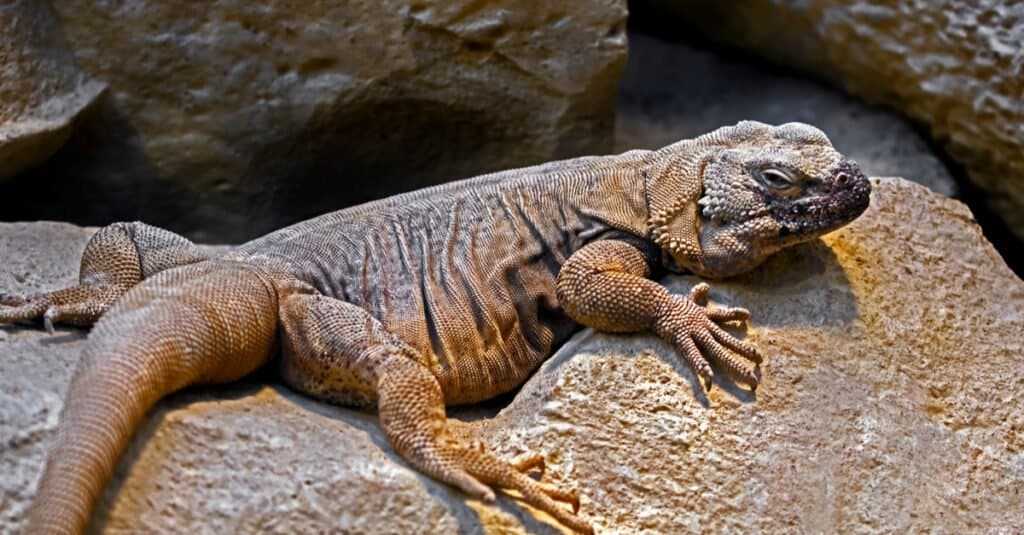
Chuckwallas start off small as babies but become very large as adults!
©Mikhail Blajenov/Shutterstock.com
Desert Tortoise
You may be hiking for a while if your goal is to see a desert turtle on Camelback Mountain. These tortoises spend about 95% of their life inside tunnels beneath the sand to beat the heat! They grow anywhere from eight to 15 inches long and 4 to 6 inches tall. The largest desert tortoise is 17 inches long and weighs 26 pounds!

Desert dwelling tortoises have hard shells in brown and gray.
©SLSK Photography/Shutterstock.com
Cottontail Rabbits
These desert rabbits have relatively long ears and are medium-sized cottontails. They feed on grasses and green plants during the hot spring and summer, and during the winter and fall months when rain is sparse, they eat bark and twigs. Like most rabbits, they are quick, and you can see their white underside when they run away. They also have white fur on their belly which stands out against their greyish-brown body.
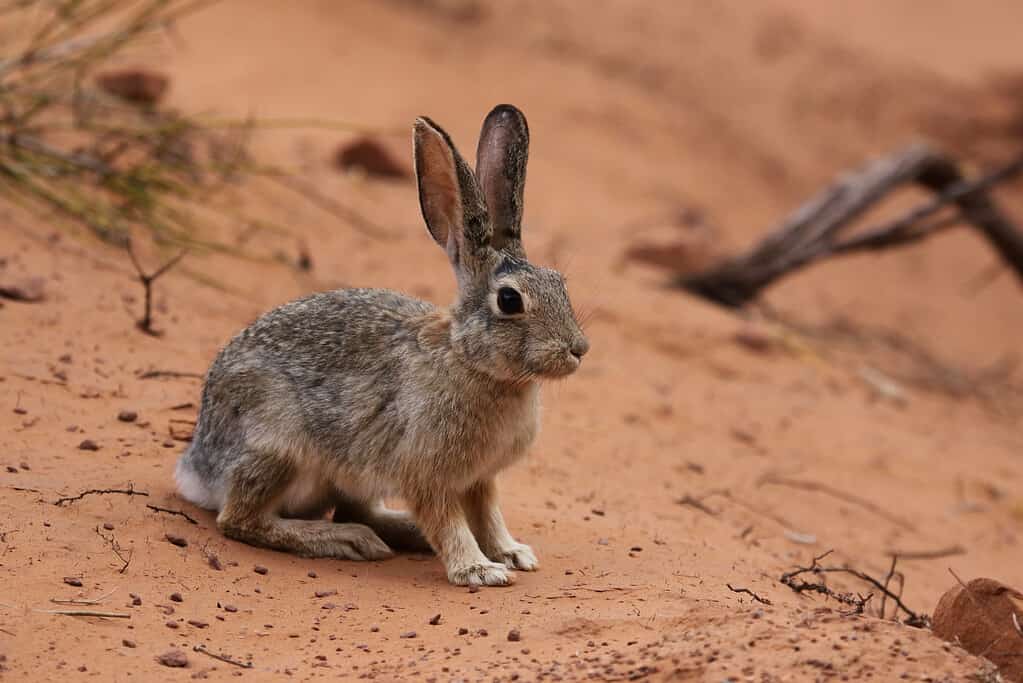
You can tell a desert cottontail from other species because its ears are larger and are more often erect.
©Chris Hill/Shutterstock.com
Plants on Camelback Mountain
There are also beautiful plants to see on the mountain. A lot of the flora include different cactus. A cactus is a type of succulent plant that stores water in its thick stems and leaves and has spines or spikes to protect itself from predators. Arizona is home to more than 50 species of cacti, such as barrel cactus, cholla, pincushion cactus, and saguaro. Some species feature beautiful flowers in shades of yellow, pink, and red that add a splash of color to any garden.
Some of the plants on Camelback Mountain include:
- Saguaro Cactus: Its bright white flowers bloom at night in the springtime.

The Saguaro cactus is an iconic symbol of the Arizona desert. It can grow 40 feet and live for 200 years!
©iStock.com/Nate Hovee
- Ocotillo
- Palo Verde
- Cholla: The five-petal, yellowish-green flowers bloom from May to August.
- Barrel Cactus
- Creosote Bush
- Prickly Pear Cacti: The amazing yellow flowers bloom from April through October.
- Mesquite Trees
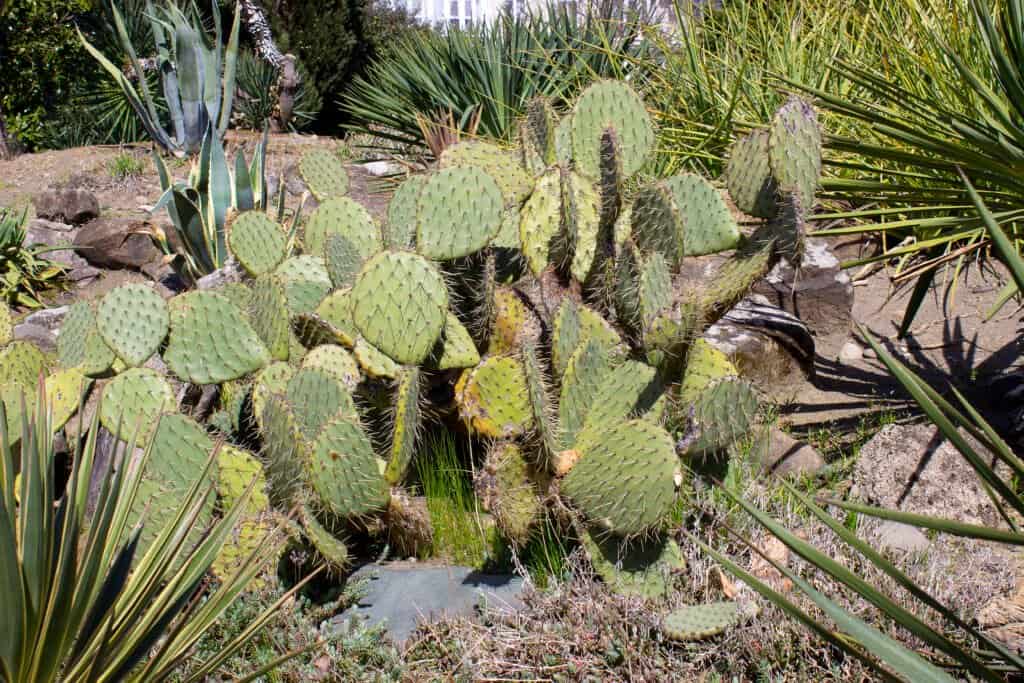
Engelmann prickly pear is a species of cactus native to the Sonoran Desert region of Arizona.
©iStock.com/Marina Krisenko
Hiking At Camelback Mountain
Camelback Mountain is picture-perfect for hiking! The mountain became a Phoenix city park in 1968, a year after the Walker McCune Mansion was built. With an elevation of 2,704 feet, there are two moderately difficult trails that are excellent climbs, Echo Canyon and Cholla. Both are open from sunrise to sunset, and Echo Canyon Trail is steeper were Cholla Trail is longer. Both trails are rated as difficult. If you are hiking without a guide, you should be an experienced hiker to reach the peaks of the mountain. Also, each summit is narrow and rocky. They both require rock climbing and rock scrambling to get to the top.
However, you can schedule a guided hike up the mountain if you are nervous about the difficulties of the trails. Also, if you plan to hike the mountain, watch out for rattlesnakes, and beware of the dry Arizona heat!
Though it can get busy because it is a hiking destination for both locals and tourists in Camelback Mountain Echo Canyon Recreation Area between Phoenix, Scottsdale, and Paradise Valley.
Comparisons Of the Largest Home in Arizona and the U.S.

Fair Field, the largest home in the country, is twice the size of the White House.
©iStock.com/bloodua
In the last 75 years, the average size of a newly constructed home in the United States has more than tripled. A new home in 1945 was around 797 square feet whereas today a new home is an average of 2,135 square feet. Americans can build bigger homes due to cheaper building materials, easier lines of credit, and single-use zoning permits.
However, homes built by wealthy tycoons over the years are still some of the largest and most opulent. Most boast 50,000 square feet or more. And though some are no longer private homes, almost all of them have stood the test of time and were even adapted for reuse. Though, today’s modern construction dwarfs some of these sprawling estates.
Here are some comparisons to show the difference in home sizes of the large homes in Arizona, the largest historic homes in the country, and the largest residential homes. You can even view a couple of the historic homes as they are publicly owned.
Home Comparisons
| Home | Location | Square Feet |
|---|---|---|
| Walker McCune Mansion | Paradise Valley, Arizona | 52,000 |
| The White House | Washington, D.C. | 55,000 |
| Silverleaf Mansion | North Scottsdale, Arizona | 100,000 (unfinished) |
| Cave Creek Mansion | Cave Creek, Arizona | 60,000 (unfinished) |
10 Largest Residential Homes In the United States
| Home | State | Square Feet |
|---|---|---|
| Fair Field | New York | 110,000 |
| The One | California | 105,000 |
| Versailles | Florida | 90,000 |
| Chateau Pensmore | Missouri | 72,215 |
| Xanadu 2.0 | Washington | 66,000 |
| Eschman Meadows | Ohio | 57,000 |
| Hala Ranch | Colorado | 56,000 |
| Chateau Montage | Alabama | 54,400 |
| Chateau Montage | Massachusetts | 54,246 |
| 10423 Willowbrook Drive, Potomac | Maryland | 53,487 |
10 Largest Historic Homes in the United States
| Home | State | Square Feet |
|---|---|---|
| The Biltmore Estate | Asheville, North Carolina | 179,000 |
| Oheka Castle | Huntington, New York | 109,000 |
| Arden House | Harriman, New York | 97,000 |
| Winterthur | Winterthur, Delaware | 97,000 |
| Great Hall | West Long Branch, New Jersey | 90,000 |
| Meadow Brook Hall | Rochester Hills, Michigan | 88,000 |
| Florham | Florham Park, New Jersey | 80,000 |
| Bourne Mansion | Oakdale, New York | 75,000 |
| Idle Hour | Oakdale, New York | 70,000 |
| Lynnewood Hall | Elkins Park, Pennsylvania | 70,000 |
The photo featured at the top of this post is © GoodFocused/Shutterstock.com
Thank you for reading! Have some feedback for us? Contact the AZ Animals editorial team.







